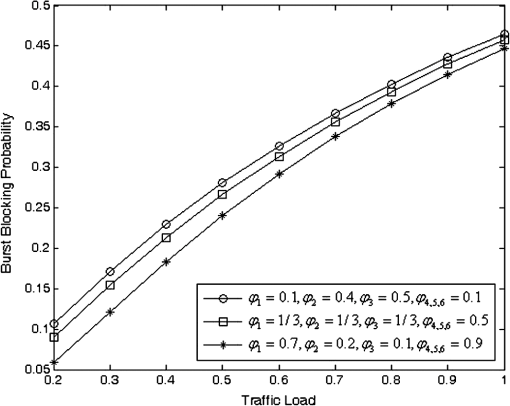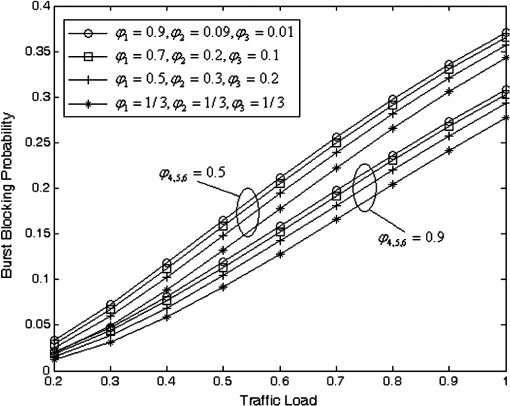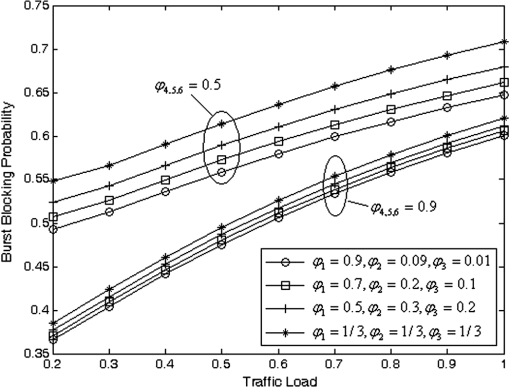|
|
1.IntroductionWith the explosive growth of data traffic in the Internet, optical burst switching (OBS) has been regarded as an ideal switching technique to realize terabit-level data transmission in next-generation optical networks.1 In an OBS core node, bursts have been processed and outputted through a reserved output port and wavelength. In reference to the outputted process of a burst, according to the studies cited in this paper, the same probability to select the output ports, which lead to the same edge node (or destination), was used. Such an assumption makes it easy to establish the burst-outputted model in an OBS core node, but it ignores the difference of the service rates of network interface units (NIUs)2,3 and the difference of output ports-selected rules based on optimal routing algorithms.4 In fact, according to the general rule of an optimal routing, if there is enough remaining wavelength in a network, it should select a shortest path; it should also increase the probability of selecting a low-load or short-delay path. The wavelength indicates that a burst will use different probabilities to select output ports that lead to the same destination in an OBS core node. In addition, different NIUs equipped at the output interface of a core node have a different data processing rate, thus directly affecting the service rate. Therefore, under such conditions, the outputting performance of bursts will show a variety of scenarios. References 5 and 6 have proposed two-output ports with two different probability output port-selected burst output models in an OBS core node. However, they only consider two output ports and different service rate situation, thus limiting the results. In this paper, we develop an analytical model for the burst output issue. In this model, we not only give a more generalized three-output port system in an OBS core node, but also consider both different service rates and different output port-selected probabilities according to different network-related conditions. 2.Analytical ModelIn this section, we develop an analytical model based on a Markov chain to evaluate the burst output issue in an OBS core node. Without loss of generality, we assume that there are three output ports, Port_A, Port_B, and Port_C that can lead to the same destination. Each output port of the core node is equipped with a NIU, and the data output performances among them are different; thus, the service rate of each port is , , and , respectively. We assume that the service rates of the three output ports are the negative exponent distributed with the relationship of , and the wavelength conversion is unavailable in our analysis. We also assume that the burst-arriving process is Poisson with rate of . Thus, burst output process in the OBS core node can be described as follows: where are steady states probabilities in the blocking OBS system, , , and denote Port_A, Port_B, and Port_C selected probability by an arriving burst at a specific moment, respectively, under the condition where all the three ports are idle at that moment. The , , and denotes the selective probability for Port_B, Port_A, and Port_C under the condition that Port_A, Port_B, and Port_A have been occupied at that moment, respectively.3.Results and DiscussionIn this section, we evaluate the burst output process under three network scenarios. We assume Port_A, Port_B, and Port_C of the OBS core node is attached with a NIU with the data rate of 100, 10, and , respectively. The average length of bursts is 12.5 M octets in the OBS network. 3.1.Different Ports-Selected ProbabilitiesDifferent from the previous work on burst output process models in the literature, which only considers the same probability to select all the output ports, here we use Fig. 1 to describe the limitation of the conventional model and explain the improvement of the proposed model. In our analysis, we assume that all the output ports can lead to the same destination through different paths. We can observe that, under the different service rate conditions, burst-blocking probability varies with the different output port-selected probabilities. It also can be seen that the burst-blocking probability with different port-selected probabilities may be either greater or less, with the same port-selected probabilities applied in the conventional work. 3.2.Effect of the Shortest Path RoutingIn this case, there is enough available wavelength for assignment. Thus, the shortest path first-routing algorithm has been applied for the entire OBS network. It means that an arriving burst will use larger probability to select the output port that leads to the shortest path in the OBS core node. We assume that Port_A leads to the shortest path, whereas Port_C leads to the longest path for a given destination. Figure 2 plots the burst-blocking probability considering the effect of the shortest path-routing algorithm. From the graph, we can observe that the burst-blocking probability increases with the increment of selective probability for Port_A under the same load condition. We also see that burst-blocking probability reduces with the increasing values of , , and under the same values of , , and . In this case, the arriving bursts use the same probability to select the three ports when they are all idle at a given moment, thus getting the lowest burst blocking probability. 3.3.Effect of Different Service RatesIn the OBS network, traffic is heavy, and there is not enough of a remaining wavelength resource for each bandwidth reservation requirement. In this case, the shortest path-routing algorithm may be inefficient or even of no use; thus, an arriving burst will select an output port with high service rate. To illustrate the effect of service rates on burst output process, we consider a reverse condition comparing with the above case that of Port_A that leads to the longest path, whereas Port_C leads to the shortest path regarding a given destination. From Fig. 3, we could observe that burst-blocking probability reduces with the increased selective probability for Port_A under the same load condition. It indicates that although bursts select an output port that leads to a long path, they get a low-blocking probability, thus improving the network-losing performance effectively in a bufferless OBS network. We also see that, similar to Fig. 2, the burst-blocking probability with large value of , , and is lower than that with a small value. However, different from Fig. 3 under the same load condition, the adjacent difference of burst- blocking probabilities among , 0.7, 0.5 and with is larger than that of , 0.7, 0.5, and with . 4.ConclusionIn this paper, we proposed an enhanced burst-outputted model in an OBS core node and evaluated burst-blocking performance considering the different service rates and output port-selected probabilities under different load conditions. The consideration of a different service rate for NIUs and different output port-selected probabilities for bursts makes the result closer to the real networks-running scenario and, thus has practical significance for the construction of OBS test beds. AcknowledgmentsThis project was supported by the Natural Science Foundation of State Ethnic Affairs Commission of China, under grant of 12ZNZ010, and the Scientific and Technological Projects of Wuhan, China, under grant of 2013010501010125. ReferencesP. P. MarinoF. Neri,
“On the myths of optical burst switching,”
IEEE Trans. Commun., 59
(9), 2574
–2584
(2011). http://dx.doi.org/10.1109/TCOMM.2011.063011.100192 IECMBT 0090-6778 Google Scholar
A. DettiV. EramoM. Listanti,
“Performance evaluation of a new technique for IP support in a WDM optical network: optical composite burst switching (OCBS),”
J. Lightwave Technol., 20
(2), 154
–165
(2002). http://dx.doi.org/10.1109/50.983228 JLTEDG 0733-8724 Google Scholar
A. A. El-RahmanS. RabiaH. M. H. Shalaby,
“MAC-layer performance enhancement using control packet buffering in optical burst-switched networks,”
J. Lightwave Technol., 30
(11), 1578
–1586
(2012). http://dx.doi.org/10.1109/JLT.2012.2187043 JLTEDG 0733-8724 Google Scholar
J. TriayC. C. Pastor,
“An ant-based algorithm for distributed routing and wavelength assignment in dynamic optical networks,”
IEEE J. Sel. Areas Commun., 28
(4), 542
–552
(2010). http://dx.doi.org/10.1109/JSAC.2010.100504 ISACEM 0733-8716 Google Scholar
R. Hou,
“A novel burst-outputted model in an OBS core router,”
Optik., 122
(24), 2195
–2198
(2011). http://dx.doi.org/10.1016/j.ijleo.2011.02.008 OTIKAJ 0030-4026 Google Scholar
R. Houet al.,
“Performance analysis of differential output ports choosing probabilities for multi-classes traffic in optical burst switching network,”
Opt. Eng., 45
(6), 065003
(2006). http://dx.doi.org/10.1117/1.2211640 OPEGAR 0091-3286 Google Scholar
BiographyRui Hou received his PhD degree in optical engineering from Huazhong University of Science and Technology, Wuhan, China, in 2006. He has authored or co-authored over 80 papers on international journals and conferences. His main research interests include computer networks, WDM networks, and optical switching. Jiana Changyue is working toward MEng at the College of Computer Science, South-Central University for Nationalities, Wuhan, China. Her interesting areas of research are computer communications and high-speed networking technologies. Tingting He is working toward a dual degree (MEng and PhD) program at the Computer School, Nanjing University of Posts and Telecommunications, Nanjing, China. She has authored or co-authored over 10 international journal papers. Her interesting areas of research are computer communications and high-speed networking technologies. Tengyue Mao received his MTech degree from the Computer School, Wuhan University, Wuhan, China, in 2002. He has authored or co-authored over 20 journal and conference papers. His active area of research is network switching technologies. Jianwei Yu received his PhD degree from Wuhan University, Wuhan, China, in 2012. He has authored or co-authored over 10 papers on international journals and conferences. His research interests are intelligent optimization algorithm, QoS-based data transmission techniques in high speed computer networks, and neural networks. |




